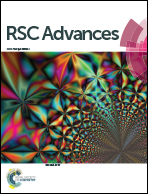CO2 and water vapor adsorption properties of framework hybrid W-ZSM-5/silicalite-1 prepared from RHA
Abstract
Framework hybrid W-ZSM-5 and W-silicalite-1 zeolites were synthesized by hydrothermal methods using rice husk ash (RHA) as a silicon raw material. RHA is a low-cost precursor material, and its use can also alleviate the environmental and human health related problems that may occur when it is stacked in open fields. A series of comparative samples were characterized by XRD, FTIR, ICP-OES, SEM, N2 adsorption–desorption and pore size analysis in order to examine their crystal structure, hybrid state, morphology and textural properties. The maximum CO2 adsorption capacities of W-ZSM-5 and W-silicalite-1 are 81.69 and 69.96 cm3 g−1, respectively, measured at 15 bar. The isotherms of CO2, N2 and O2 are perfectly fitted by the Toth model, and it is noted that the presence of Al atoms increases the heterogeneity. It can be seen that the greater the heterogeneity of the adsorbent, the larger the CO2 adsorption capacity achieved. The incorporation of tungsten into the framework does not affect the crystallization of the zeolite, but it prevents the formation of silanol and O–H groups at the adsorption sites. Therefore, the CO2/H2O selectivity of W-ZSM-5 is slightly higher than that of ZSM-5, and that of W-silicalite-1 is three times that of silicalite-1. W-ZSM-5/silicalite-1 are promising adsorbents for separating CO2 under humid industrial conditions.



 Please wait while we load your content...
Please wait while we load your content...